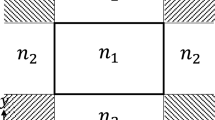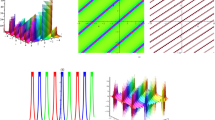Abstract
In this paper, a Timoshenko dielectric beam model with the consideration of the direct flexoelectric effect is developed by using the variational principle. The governing equations and the corresponding boundary conditions are naturally derived from the variational principle. The effect of flexoelectricity on the Timoshenko dielectric beams is analytically investigated. The developed beam model recovers to the classical Timoshenko beam model when the flexoelectricity is not taken into account. To illustrate this model, the deflection and rotation of Timoshenko dielectric nanobeam under two different boundary conditions are calculated. The numerical results reveal that both the deflection and rotation predicted by the current model are smaller than those predicted by the classical Timoshenko beam model. Moreover, the discrepancies of the deflection and rotation between the values predicted by the two models are very large when the beam thickness is small. The current model can also reduce to the Bernoulli–Euler dielectric beam model wherein the shear deflection is not considered. This work may be helpful in understanding the electromechanical response at nanoscale and designing dielectric devices.






Similar content being viewed by others
References
Craighead HG (2000) Nanoelectromechanical systems. Science 290(5496):1532–1535
Ekinci K, Roukes M (2005) Nanoelectromechanical systems. Rev Sci Instrum 76(6):061101
Majdoub MS, Sharma P, Cagin T (2008) Enhanced size-dependent piezoelectricity and elasticity in nanostructures due to the flexoelectric effect. Phys Rev B 77(12):125424
Sharma N, Landis C, Sharma P (2010) Piezoelectric thin-film superlattices without using piezoelectric materials. J Appl Phys 108(2):024304
Fleck N, Muller G, Ashby M, Hutchinson J (1994) Strain gradient plasticity: theory and experiment. Acta Metall Mater 42(2):475–487
Kong S, Zhou S, Nie Z, Wang K (2009) Static and dynamic analysis of micro beams based on strain gradient elasticity theory. Int J Eng Sci 47(4):487–498
Shen SP, Hu SL (2010) A theory of flexoelectricity with surface effect for elastic dielectrics. J Mech Phys Solids 58(5):665–677
Ma W, Cross LE (2001) Large flexoelectric polarization in ceramic lead magnesium niobate. Appl Phys Lett 79(26):4420–4422
Ma W, Cross LE (2001) Observation of the flexoelectric effect in relaxor Pb(Mg1/3Nb2/3) O3 ceramics. Appl Phys Lett 78(19):2920–2921
Maranganti R, Sharma N, Sharma P (2006) Electromechanical coupling in nonpiezoelectric materials due to nanoscale nonlocal size effects: Green’s function solutions and embedded inclusions. Phys Rev B 74(1):014110
Liang X, Shen SP (2013) Size-dependent piezoelectricity and elasticity due to the electromechanical field-strain gradient coupling and strain gradient elasticity. Int J Appl Mech 5(2):1350014
Mindlin R, Tiersten H (1962) Effects of couple-stresses in linear elasticity. Arch Ration Mech Anal 11(1):415–448
Mindlin RD (1965) Second gradient of strain and surface-tension in linear elasticity. Int J Solids Struct 1(4):417–438
Asghari M, Kahrobaiyan M, Ahmadian M (2010) A nonlinear Timoshenko beam formulation based on the modified couple stress theory. Int J Eng Sci 48(12):1749–1761
Yang F, Chong ACM, Tong P (2002) Couple stress based strain gradient theory for elasticity. Int J Solids Struct 39:2731–2743
Ma H, Gao X-L, Reddy J (2008) A microstructure-dependent Timoshenko beam model based on a modified couple stress theory. J Mech Phys Solids 56(12):3379–3391
Hu SL, Shen SP (2009) Electric field gradient theory with surface effect for nano-dielectrics. CMC Comput Mater Contin 13(1):63–87
Hadjesfandiari AR (2013) Size-dependent piezoelectricity. Int J Solids Struct 50(18):2781–2791
Hadjesfandiari AR (2014) Size-dependent theories of piezoelectricity: comparisons and further developments for centrosymmetric dielectrics. arXiv preprint arXiv:14091082
Darrall BT, Hadjesfandiari AR, Dargush GF (2015) Size-dependent piezoelectricity: a 2D finite element formulation for electric field-mean curvature coupling in dielectrics. Eur J Mech A Solids 49:308–320
Li A, Zhou S, Zhou S, Wang B (2014) Size-dependent analysis of a three-layer microbeam including electromechanical coupling. Compos Struct 116:120–127
Majdoub MS, Sharma P, Cagin T (2008) Dramatic enhancement in energy harvesting for a narrow range of dimensions in piezoelectric nanostructures. Phys Rev B 78(12):121407
Shen S, Kuang ZB (1999) An active control model of laminated piezothermoelastic plate. Int J Solids Struct 36(13):1925–1947
Le Quang H, He QC (2011) The number and types of all possible rotational symmetries for flexoelectric tensors. Proc R Soc Lond A Math Phys Eng Sci 467(2132):2369–2386
Shu L, Wei X, Pang T, Yao X, Wang C (2011) Symmetry of flexoelectric coefficients in crystalline medium. J Appl Phys 110(10):104106
Liu CC, Hu SL, Shen SP (2012) Effect of flexoelectricity on electrostatic potential in a bent piezoelectric nanowire. Smart Mater Struct 21(11):115024
Asghari M, Rahaeifard M, Kahrobaiyan M, Ahmadian M (2011) The modified couple stress functionally graded Timoshenko beam formulation. Mater Des 32(3):1435–1443
Ma WH, Cross LE (2006) Flexoelectricity of barium titanate. Appl Phys Lett 88(23):232902
Acknowledgments
The supports from NSFC (Grants Nos. 11025209, 11372238, 11302161, 11321062, 11302162) are appreciated.
Author information
Authors and Affiliations
Corresponding authors
Rights and permissions
About this article
Cite this article
Zhang, R., Liang, X. & Shen, S. A Timoshenko dielectric beam model with flexoelectric effect. Meccanica 51, 1181–1188 (2016). https://doi.org/10.1007/s11012-015-0290-1
Received:
Accepted:
Published:
Issue Date:
DOI: https://doi.org/10.1007/s11012-015-0290-1




